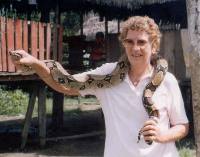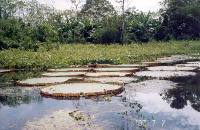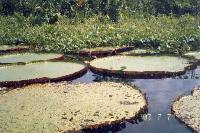Click images to enlarge
One of my aims on this trip was to see the Victoria amazonica (known also as Victoria regia or regina), a water plant with huge round leaves and a beautiful flower which blooms only two nights and one day. What I learned though was that these plants only grow in still low waters where there is no current and, therefore, not anywhere near to where we were. At my insistence the lodge guides arranged for Guillermo and me to be taken inland and, after a ride in the smallest canoe which I thought would topple and sink, we were finally able to see those glories. I asked if, in that environment, there might be snakes and other beasts. The Indian guide told me yes, there were plenty of snakes and "lagartos", the Spanish for big lizards. As I asked what kind of lagartos because we call them something else, like caiman, he nonchalantly said, oh, yes, there is an old fellow who lives just beyond those trees back there in the water but he is small, only about 5 metres long. Well, that was sufficient for me to ask him to please quickly bring me ashore.

Having passed that little experience he then produced from his hut (on stilts) a boa constrictor of such beauty, about his size and with huge red spots on his tail. He told me that it was all right to carry as long as I held its head and its tail.
Having seen just this very small part of Amazonia, one can well imagine what the rest must be like, the one still bordering the rest of Peru, then Colombia, Ecuador, Bolivia and of course Brasil. We did see lots of HUGE logs which had been felled from the forest, floating in backwaters and tied with chains waiting to be ferried to the mills near Iquitos, and now understand why these forests must be protected more seriously from the avariciousness of civilization. The woods, we were told, go the United States and Europe, beautiful big and old trees which have taken so long to grow. It touches you.
 |
|
 |



